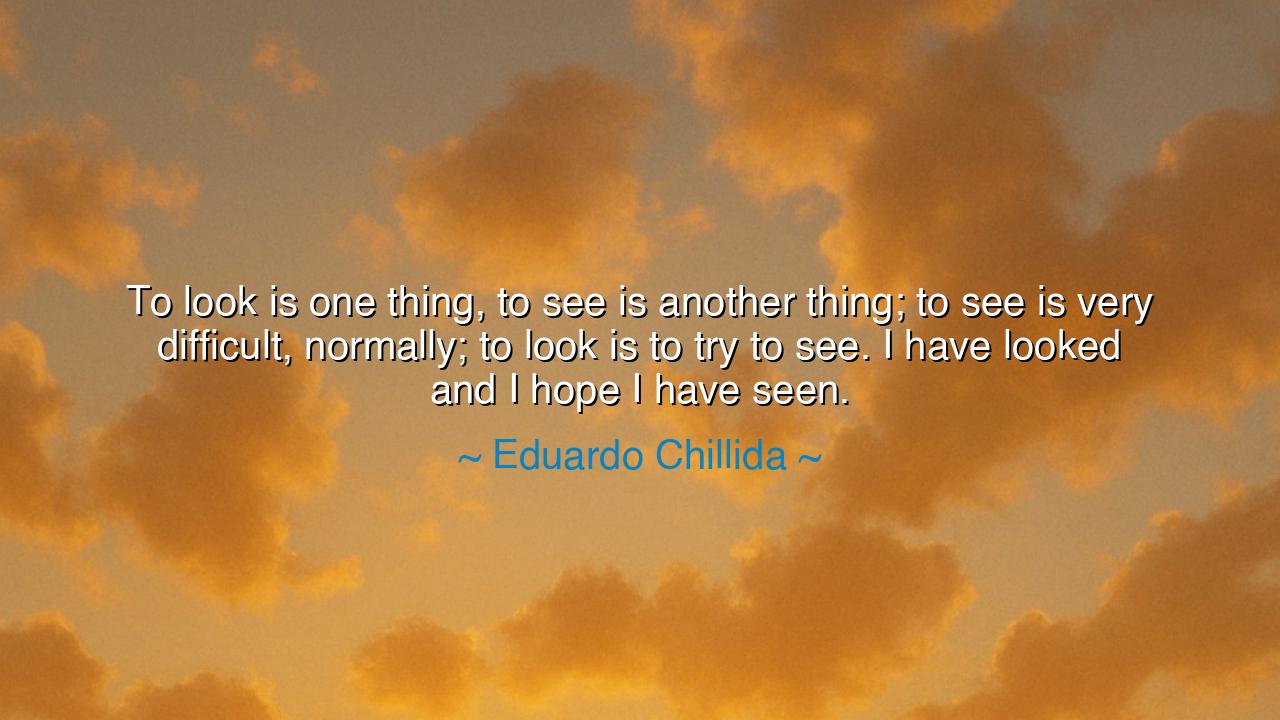
To look is one thing, to see is another thing; to see is very
To look is one thing, to see is another thing; to see is very difficult, normally; to look is to try to see. I have looked and I hope I have seen.






“To look is one thing, to see is another thing; to see is very difficult, normally; to look is to try to see. I have looked and I hope I have seen.”
Thus spoke Eduardo Chillida, the sculptor of silence and stone, whose hands shaped space itself into thought. In these words, simple yet profound, he reveals the ancient distinction between appearance and understanding, between the act of looking and the art of truly seeing. For to look is easy—it requires only the eyes. But to see—to perceive the essence beneath the form, the soul beneath the surface—this is the labor of the spirit. Chillida’s statement is not only about art, but about life, for he speaks of the universal challenge: to awaken one’s perception from blindness to awareness, from habit to revelation.
The origin of this reflection lies in Chillida’s lifelong meditation on the relationship between matter and space. Born in the Basque country, he sculpted iron, steel, and stone, not merely to shape them, but to reveal what was already there—what the ordinary eye could not perceive. His creations were dialogues with the unseen, conversations between weight and emptiness, between presence and absence. In his art, as in his philosophy, he understood that reality hides its truth from the casual observer. Thus he confessed, with humility and hope, “I have looked and I hope I have seen,” as though uncertain whether his lifetime of creation had been enough to pierce the veil of appearances.
In these words we hear an echo of the ancients. The philosopher Plato taught that most men live like prisoners in a cave, watching shadows upon the wall, mistaking them for reality. Only the few who dare to turn toward the light—who seek to see rather than merely look—can grasp truth itself. Chillida’s insight follows this same lineage: that the eye is a gate, but not the destination. One must enter deeper, into the realm of contemplation, where vision becomes understanding. To look without seeing is to wander the surface of life; to see is to touch eternity.
Consider, too, the life of Leonardo da Vinci, that master of observation. He looked at clouds and saw the patterns of motion; he studied the curve of a smile and saw the mystery of the human soul. To others, the world was a collection of things—to him, it was a network of meanings. What made him genius was not the sharpness of his sight, but the depth of his seeing. So it is with all who truly awaken: they do not merely witness the world; they converse with it. They hear in its silence the voice of truth.
Chillida reminds us that to look is to try to see—that the act of looking, when done with intention, is the beginning of seeing. It is the practice of attention, of humility before what is. In an age of haste and distraction, his words strike with the quiet force of wisdom. We live surrounded by images, yet we seldom perceive their meaning; we hear countless words, yet understand little. True seeing demands stillness. It demands patience, and the courage to face what lies beyond the visible. To see is to encounter the sacred reality that hides beneath all things.
And yet, in his final words—“I have looked, and I hope I have seen”—there is both modesty and triumph. The artist, like the philosopher, never claims mastery over truth. He seeks, he questions, he wrestles with the mystery, and in that struggle finds purpose. Chillida does not assert that he has seen, but that he hopes he has—and this hope is the essence of wisdom. For to see even a fragment of truth is a grace, and the longing to see more is the mark of the awakened soul.
So, O listener, take this lesson into your own life: look deeply. Do not pass over the world with hurried eyes. Look at the face of another, and try to see the life behind it. Look at the sky, not merely as color, but as the breath of the infinite. Look at your own heart, and seek what lies beneath desire and fear. For if you learn to see, truly see, even once, your life will never be the same. As Chillida teaches, to look is the beginning of wisdom, but to see is to awaken to the eternal. And though few may ever see fully, it is enough—indeed, it is noble—to keep looking.






AAdministratorAdministrator
Welcome, honored guests. Please leave a comment, we will respond soon